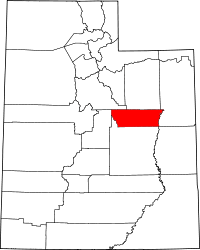Hiawatha, Utah
| Hiawatha, Utah | |
|---|---|
| Ghost town | |
|
A few of the structures left at Hiawatha | |
 Hiawatha  Hiawatha Location of Hiawatha in Utah | |
| Coordinates: 39°29′3.61″N 111°00′47.05″W / 39.4843361°N 111.0130694°WCoordinates: 39°29′3.61″N 111°00′47.05″W / 39.4843361°N 111.0130694°W | |
| Country | United States |
| State | Utah |
| County | Carbon |
| Incorporated | 1911 |
| Disincorporated | November 20, 1992 |
| Named for | Hiawatha, a pre-colonial Native American leader[1] |
| Elevation[2] | 7,264 ft (2,214 m) |
| GNIS feature ID | 1428681[2] |
| Historical population | |||
|---|---|---|---|
| Census | Pop. | %± | |
| 1930 | 939 | — | |
| 1940 | 858 | −8.6% | |
| 1950 | 1,421 | 65.6% | |
| 1960 | 439 | −69.1% | |
| 1970 | 166 | −62.2% | |
| 1980 | 249 | 50.0% | |
| 1990 | 43 | −82.7% | |
Hiawatha is a ghost town, formerly a coal mining town in Carbon County, Utah, United States. The town is located at the base of Gentry Mountain, some 12 miles (19 km) southwest of Price. It used to be a vibrant mining town, with a population of above 1,500 in the 1940s. Coal was discovered here in 1909, a mine was built, a railroad was constructed, and the city was incorporated in 1911. Another nearby village called Blackhawk was merged with Hiawatha in 1915.
Hiawatha was a company town. The United States Fuel Company, which owned the Hiawatha mine and had its headquarters there, essentially ran the town.[3] After the 1940s, production began to drop and people moved away. The population fell from 439 in 1960, to 43 in 1990. The city was disincorporated on November 20, 1992.
On December 12, 1997, the permit for the Hiawatha Mines Complex was transferred from U.S. Fuel Company to Hiawatha Coal Company.[4] The company plans to recommence mining in the near future. In September 2006, the Carbon County commission approved the rezoning of three of Hiawatha's six sections as residential, at the request of the property owner ANR Inc.[5] It is estimated that around three or four families currently live in Hiawatha. Some homes have been remodeled, and further construction is ongoing.
Hiawatha was also notable for having a vibrant Greek immigrant community, particularly from the island of Crete.
See also
- John E. Moss, a politician born in Hiawatha
Climate
This climatic region is typified by large seasonal temperature differences, with warm to hot (and often humid) summers and cold (sometimes severely cold) winters. According to the Köppen Climate Classification system, Hiawatha has a humid continental climate, abbreviated "Dfb" on climate maps.[6]
References
- ↑ Van Atta, Dale (Jan 22, 1977). "You name it - there's a town for it". The Deseret News. pp. W6. Retrieved 18 October 2015.
- 1 2 U.S. Geological Survey Geographic Names Information System: Hiawatha
- ↑ Carr, Stephen L. (1986) [June 1972]. The Historical Guide to Utah Ghost Towns (3rd ed.). Salt Lake City, Utah: Western Epics. p. 83. ISBN 0-914740-30-X.
- ↑ "Permit C007011". Utah Department of Natural Resources, Division of Oil, Gas and Mining. Retrieved 2007-12-19.
- ↑ Bowen, Les (September 12, 2006). "Commission denies request for approval of 12-lot subdivision". Sun Advocate. Retrieved 2007-12-19.
- ↑ Climate Summary for Hiawatha, Utah
External links
- Don Strack. "Old Hiawatha Mine". Utah Rails—Utah Fuels the West: Utah's coal industry and the railroads that served it. Retrieved 2007-11-15.
- Wallace R. Baldwin. "Hiawatha, Utah: Black Coal Dust and White, White Snow". Retrieved 2007-11-15.


